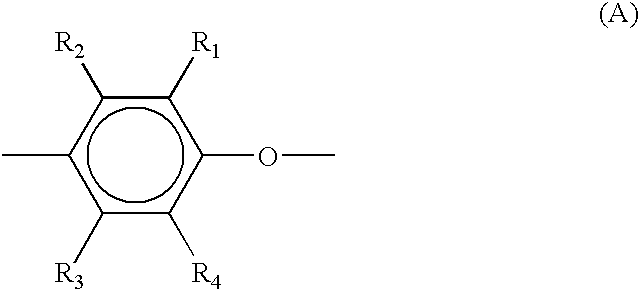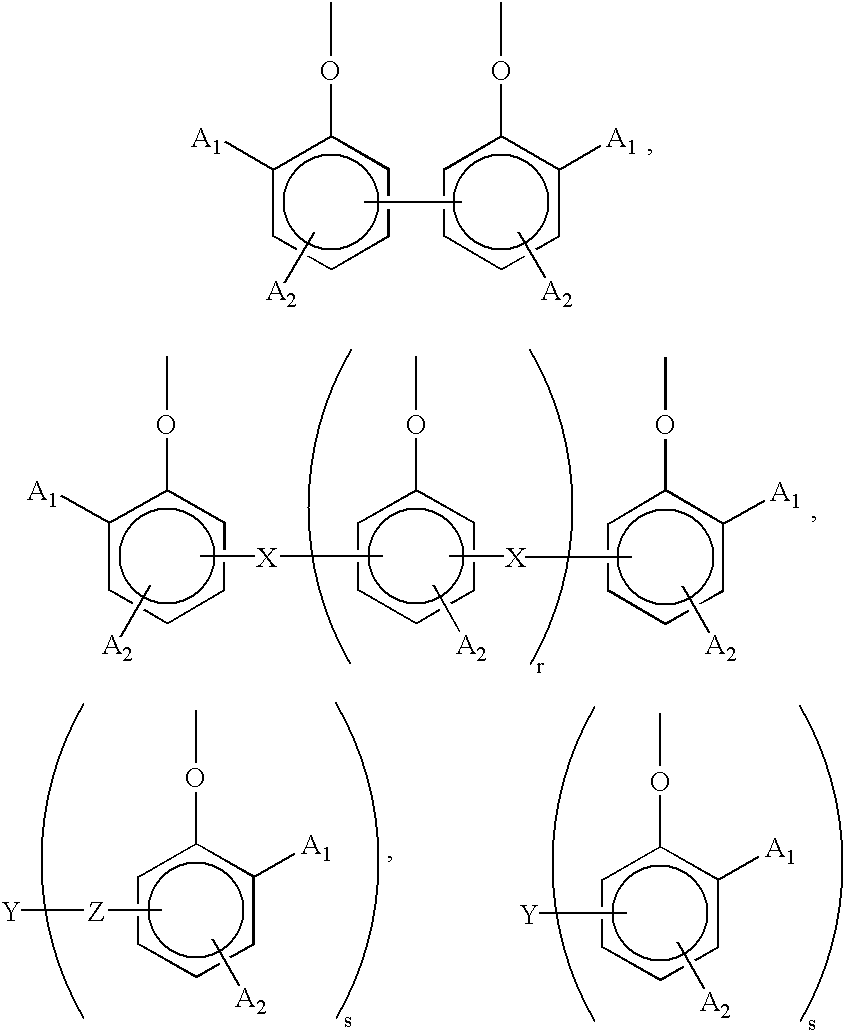Curable sheet for circuit transfer
a technology of curable sheets and circuits, applied in electrical devices, metal layered products, metal pattern materials, etc., can solve the problems of difficult high-density interconnection, limit circuit design, and essentially difficult to heighten yield, and achieve the effect of simplifying the multiplayer lamination
- Summary
- Abstract
- Description
- Claims
- Application Information
AI Technical Summary
Benefits of technology
Problems solved by technology
Method used
Image
Examples
example 1
The above-described modified polyphenylene ether resin, hydrogenated block copolymer, triallyl isocyanurate and, as a bromine flame-retardant, Saytex BT-93W were added, at the composition as shown in Table 2, to toluene of 80.degree. C., followed by stirring for 1 hour to dissolve the former in the latter. A polymerization initiator was added at the composition as shown in Table 2. Then, silica was added at the composition as shown in Table 2 to disperse it in the mixture, whereby the corresponding varnish was prepared. The resulting varnish was applied to a PET film of 100 .mu.m thick by a blade coater, followed by drying in an air oven at 50.degree. C. for 30 minutes. Then, the PET film was peeled, whereby a curable sheet of 100 .mu.m thick was prepared. A through-hole of 0.1 mm in diameter was made in the thus-prepared curable sheet by a CO.sub.2 gas laser. A conductive paste containing silver-plated copper particles was filled in the through-hole to form a via-hole conductor.
An ...
examples 2 to 4
In a similar manner to Example 1 except that the composition ratio of each of the modified polyphenylene ether resin, hydrogenated block copolymer, triallyl isocyanurate, brominated flame retardant, silica and polymerization initiator was changed as shown in Table 2, a multilayer wiring board was produced.
As a result of observation of the cross-section of the multilayer wiring board thus formed at the position near the wiring circuit layer or via-hole conductor, it has been found that the wiring circuit layer formed by transfer was embedded in the insulating layer enough to form a flat surface and that the wiring circuit layer and via-hole conductor were connected well. As a result of the continuity test between interconnects, no disconnection was recognized.
The unit of each of the above-described components other than spherical silica is parts by weight based on 100 parts by weight of (A)+(B), while that of spherical silica is vol. % based on the whole amount. Modified PPE resin: m...
example 5
In toluene of 80.degree. C., were dissolved 50 parts of the above-described modified polyphenylene ether resin and 50 parts by weight of triallyl isocyanurate. To the resulting solution, successively added were 25 parts by weight of Saytex 8010 (trade name; product of Albemarle Corporation) as a flame retardant and 6 parts by weight of "Perhexyne 25B" as a polymerization initiator, whereby a varnish formed of the resulting polyphenylene ether resin composition was formed. A glass cloth was impregnated with the varnish, followed by drying in an air oven to form a composite prepreg.
A through-hole was made in the prepreg by a CO.sub.2 gas laser. After a conductive paste containing a silver-plated copper powder was filled in the hole as in Examples 1 to 4, a wiring circuit layer made of the copper foil was formed by transfer, whereby one wiring layer unit was obtained.
Three wiring layers were stacked one after another. A curable sheet having the composition similar to that prepared in E...
PUM
| Property | Measurement | Unit |
|---|---|---|
| Percent by mass | aaaaa | aaaaa |
| Percent by mass | aaaaa | aaaaa |
| Percent by mass | aaaaa | aaaaa |
Abstract
Description
Claims
Application Information
 Login to View More
Login to View More - R&D
- Intellectual Property
- Life Sciences
- Materials
- Tech Scout
- Unparalleled Data Quality
- Higher Quality Content
- 60% Fewer Hallucinations
Browse by: Latest US Patents, China's latest patents, Technical Efficacy Thesaurus, Application Domain, Technology Topic, Popular Technical Reports.
© 2025 PatSnap. All rights reserved.Legal|Privacy policy|Modern Slavery Act Transparency Statement|Sitemap|About US| Contact US: help@patsnap.com



